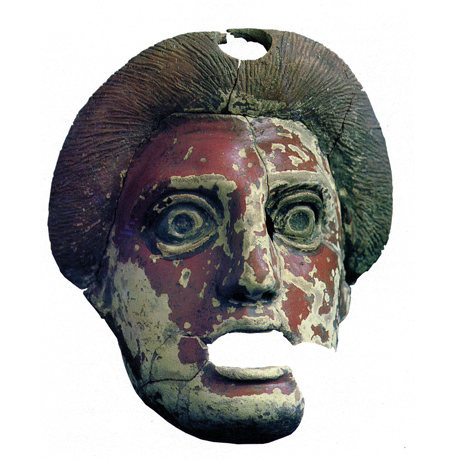by Miriam Ziino
The largest complex of masks, figurines and craters with figures of theatrical character on display today at the Aeolian Archaeological Museum.
Forty years of archaeological digs in the Aeolian Islands, especially in Lipari, have brought to light the biggest collection of masks, statuettes and kraters relating to the theatre.
Now on show at the Aeolian Archaeological Museum, they constitute the most complete documentation in the Greek world of finds connected with the theatrical theme. The vastest and most complete corpus of works related to theatre masks and stage costumes that has come down to us from classical antiquity, an actual “seam of theatre memory”.
These very important finds – which take us more or less entirely through two centuries of Greek theatre – came about due to a wholly exceptional fact linked to the singularity of the island. The Greek burial ground on Lipari is perhaps the only one that has come down to us virtually intact, having escaped the vandalism to which others were subjected over the centuries.
This was the result of a special geological wind-borne phenomenon that greatly increased the topsoil. So we were able to retrieve more than one thousand items of extraordinary manufacture.
Chronologically, Lipari pottery ranges from the second half of the 4th century BC to the 3rd century, with a series of masks for tragedy and comedy which, together with satirical drama, make up the three genres into which theatre production was divided.
With their immediate testimony these little terracottas take us through the fundamental moments of classical culture and Greek theatre, from the age of the great tragedians Sophocles and Euripides to the new comedy of Menander who, as early as the first half of the 3rd century, had won over all the theatres in the Greek world.
This local pottery production suddenly came to a drastic end when the Romans destroyed Lipari in 252 BC, bringing a whole cultural process to a close.
So these terracottas open up a broad, new field to research and make a substantial contribution to the history of Greek theatre as a whole. But they are also an expression of the high level of craftsmanship achieved in Lipari in that period, preceding by more than two centuries the widespread marble portraits of the Roman age.
A unique relationship then, found nowhere else in the world. Through excavation data and typological-stylistic study of the individual pieces we can trace the evolution of this ceramic production, an evolution that faithfully followed that of Greek theatre productions of the same period, also from the literary point of view.
The stage costume – documented by our terracottas – is in fact inseparable from the literary genre to which it refers and is the natural completion and obvious expression thereof.
This rare and exceptional collection can be seen at the Aeolian Archaeological Museum where, through scientific studies and advanced technologies, the material has been restored, preserved and exhibited in a rigorous, evocative and efficacious manner.
Another singular aspect of this exceptional art form is that it refers essentially to the cult of the dead. This is borne out by the fact that these small terracottas come almost exclusively from the burial ground where they were frequently found around the graves. They must have been brought as offerings, as we today bring flowers. But the very widespread use of theatre-related terracottas as a funeral offering can only be explained by the sacred nature attributed to them.
So the discovery of this corpus of terracottas has aroused multiple interests. First and foremost they clearly bear witness to a widespread presence of the Dionysian cult which moreover took on quite special aspects on the island, more than anywhere else in the Greek world, and enjoyed particular religious autonomy.
Theatre-related terracottas offered to the dead is in fact related to the complex personality of Dionysus, one of the most interesting figures in the Greek Pantheon: the god of wine, of drunkenness, but also god of the theatre who at the same time offers beatitude beyond the grave to those who are initiated into his mysteries. The Lipari burial ground once again offers exceptionally rich documentation of a process which was not so much artistic expression as popular religiosity.
In the evolution of this production the earliest and longest period, corresponding to the whole of the 4th century BC, relates to the tragedy of Sophocles and Euripides, and above all to the comedy of Aristophanes, i.e. to what Alexandrian grammarians of the 2nd century BC called antique drama but which continued throughout the 4th century with the name of Middle Comedy.
In the case of tragedy the discovery of theatre figurations of this kind was highly important because we knew very little about the tragic masks of the period and it is believed that they actually depict the image created for the original play. In fact some finds have borne witness to lost works: for example, we know from literature that the sufferings of Philoctetes had become a recurrent motif in Greek sculpture but we had only the literary datum.
Whereas among our finds there is an extraordinary mask which shows with visual immediacy just what those sufferings were. At time of writing this first group of theatre-related ceramics constitutes unique documentation of theatre costume in the Greek world of which, moreover, very little was known.
But the 3rd century BC is perhaps the most interesting period of this fascinating journey. A completely renewed phase, represented by the splendid masks of the new comedy whose chief exponent was the Athenian Menander.
The burial ground finds demonstrate that a wholly new typology spread in the first half of the 3rd century. It was a complete renewal also from the stylistic viewpoint of our masks. We get the impression that this change involved all classes of the craft, tragic, comic and satirical masks. So there was a deep transformation of the whole organisation of the theatre itself, a transformation that must have begun in Athens, the reference point of literary, artistic and theatre life. The types of masks now used would last throughout the age of the Roman empire.
The Lipari terracottas referable to the new comedy amount to about four hundred so far. Julius Pollux, a writer of the Roman imperial age (2nd century AD), has left us a fascinating descriptive catalogue of Menander’s masks in the Onomastikon, a sort of encyclopaedic lexicon. The treatise on theatre and the catalogue of the masks are in the fourth of ten volumes and our masks are described, subdivided into four categories (examined in detail in the present book) including what is perhaps the masterpiece of Lipari ceramics: what Pollux calls téleion etairikón, ethereality perfected, the fifth essence of perfection.
Almost all the characters in the list are found in the Lipari terracottas which fully correspond to the catalogue, in small models of masks that have often retained an extraordinary polychrome freshness, with vivacious colours obtained through the use of local kaolin.
As an appendix to the book there is an interesting chapter regarding the staging of the antique through reconstruction of the Lipari masks. A singular aspect of this project, the work of Adriano Iurissevich, is the use of theatre masks reconstructed on the basis of archaeological finds from the Greek burial ground.
The masks were recreated in life size with a sophisticated technique, setting out from a three-dimensional digital scan of the miniature finds. So full scale masks were created from the miniatures found in the Greek burial ground at Lipari. This led to “Menander in Masks, A Study of the Staging of Menander’s Dyskolos”. The play is the finale of a project initiated by Glasgow University and subsequently embraced by various bodies through which, after more than two thousand years and by means of technology so far from the simplicity of the material with which these masks express themselves, Menander’s characters once more come to life.
Summary

Article Name
Pròsopon: the face of classical theatre in the terracottas
Description
The largest complex of masks, statuettes and craters with theatrical figures on display today at the Aeolian Archaeological Museum
Author
Miriam Ziino
Publisher Name
Miriam Ziino
Publisher Logo






